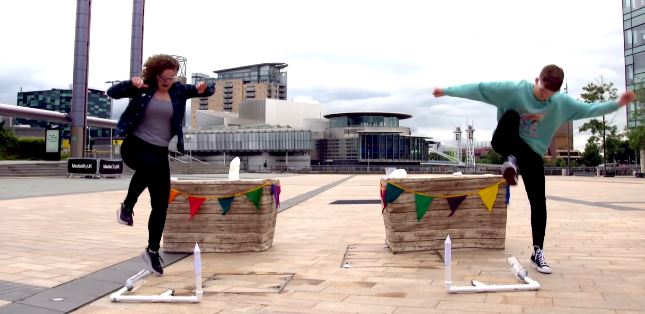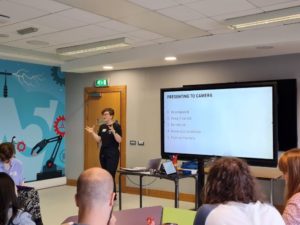This summer I was lucky enough to spend 3 full days at the BIG (British Interactive Group) Event in Belfast – an annual gathering of communication professionals specializing in STEM (Science, Technology, Engineering, and Maths).
At the event you’ll find people who love to inspire, entertain, and educate the scientists of the future, working across the world in museums, science centres, universities – and anywhere else you can think of! The event was jam-packed with interesting sessions, fascinating people, and weird and wonderful science demonstrations.
I was lucky enough to deliver a session on something I love to do – presenting science on screen. I started in science communication as a presenter and Explainer with the Science Museum Group (SMG), doing live shows, workshops and demonstrations.
In the past couple of years I’ve been lucky enough to do some work for BBC Bitesize, with SMG and as a freelancer, and last summer I got to set off some rockets on Blue Peter! It turns out that while I really like doing live shows – I also really love being on camera!

And so my session at BIG, co-presented with the wonderful Sarah Cosgriff, was about just that – sharing science in front of a camera. Sarah is a successful freelance science communicator (along with several other fascinating jobs), and creates excellent science content on TikTok.
Between the two of us we thought we just about had enough of experience to justify our session’s title – TikTok to TV: science presenting on screen.
Here are some of the top tips that we had to share:
- Be prepared
Whether you’re memorising a script or using a teleprompter, it’s important for any presenter to know what they’re going to say before filming begins. Find time to rehearse out loud if you can, and if you’re doing any demonstrations, make sure you practice those as well – preferably so that it looks (roughly!) the same each time you do it. If you’re working with a film crew then time is money, and the more prepared you are the more efficient you can be on the day – and if you’re filming at home, you get to save your own time too!

2. Keep it varied
While it’s important to keep the energy up while presenting, it’s also important to vary your tone throughout. Take your time, and feel free to pause when you need to – especially after asking a question. Variety can help keep the viewer interested, and make sure you’re sounding as natural as possible. Try listening back to yourself when you can – this is a great opportunity to check your audio quality too.
3. Be natural
When asked about their favourite presenters, most people will mention how natural or authentic they are. This is easier said than done! It can help to imagine that you’re talking to a friend while presenting, or someone else you feel comfortable around.
4. Know your audience
Unlike live presenting, where you may be talking to lots of people at once, it’s important to remember that the viewer is only one person. That’s true even if they’re watching the video in a group, or with other people. So it’s important to use the singular “you” when talking, and not refer to “the people at home” or “everyone watching” – unless you have a really good reason to (like the director says so!)
5. Eyes on the lens

When presenting in person, it’s important to scan the audience and not maintain eye contact with one person for too long. This isn’t the case when presenting on camera! It’s very important to keep ‘eye contact’ with the centre of the lens (or as close to it as possible). Although you can look away, these looks need to be deliberate – because you’re looking at a prop that the viewer can also see, for example. ‘Sneaky’ looks away are very obvious to the viewer, and can be distracting.
6. Know your shots
It’s important to know how much of your body is in frame, especially if you’re being filmed at multiple distances (e.g. a close up of your hands while holding a prop, a medium shot of a table-top demonstration, or a wide shot of a large scale demonstration). In general, the more of your body is in the shot the more freedom you have to move around, whereas very small movements will be magnified in tighter shots.

7. Anchor yourself
A general guideline (but not a hard and fast rule!) is to keep your lower body anchored to the floor, while letting your upper body move more freely. Let your hands move naturally, the way you would in conversation – if you try and keep them still there’s a good chance this movement will come out in other ways, like swaying or bouncing. Any repetitive movements will be magnified on camera, especially if you’re a fidgeter like me!
These are all things I’ve picked up from presenter training, watching other brilliant presenters, or that I’ve learnt by doing. Like most things, the best way to get better at presenting on camera is to give it a go! If you have a phone, you have what you need to get started.
You can find out more about SMG’s collaborations with BBC Bitesize here and check out Hannah in action here.